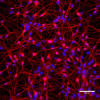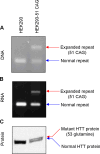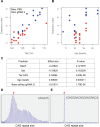Base editing strategies to convert CAG to CAA diminish the disease-causing mutation in Huntington's disease
- PMID: 38869243
- PMCID: PMC11175616
- DOI: 10.7554/eLife.89782
Base editing strategies to convert CAG to CAA diminish the disease-causing mutation in Huntington's disease
Abstract
An expanded CAG repeat in the huntingtin gene (HTT) causes Huntington's disease (HD). Since the length of uninterrupted CAG repeat, not polyglutamine, determines the age-at-onset in HD, base editing strategies to convert CAG to CAA are anticipated to delay onset by shortening the uninterrupted CAG repeat. Here, we developed base editing strategies to convert CAG in the repeat to CAA and determined their molecular outcomes and effects on relevant disease phenotypes. Base editing strategies employing combinations of cytosine base editors and guide RNAs (gRNAs) efficiently converted CAG to CAA at various sites in the CAG repeat without generating significant indels, off-target edits, or transcriptome alterations, demonstrating their feasibility and specificity. Candidate BE strategies converted CAG to CAA on both expanded and non-expanded CAG repeats without altering HTT mRNA and protein levels. In addition, somatic CAG repeat expansion, which is the major disease driver in HD, was significantly decreased in the liver by a candidate BE strategy treatment in HD knock-in mice carrying canonical CAG repeats. Notably, CAG repeat expansion was abolished entirely in HD knock-in mice carrying CAA-interrupted repeats, supporting the therapeutic potential of CAG-to-CAA conversion strategies in HD and potentially other repeat expansion disorders.
Keywords: CAG repeat instability; CAG-to-CAA conversion; Huntington's disease; base editing; duplicated interruption; genetics; genomics; human; uninterrupted repeat.
© 2023, Choi et al.
Conflict of interest statement
DC, JS, SZ, EH, JJ, JL, HS No competing interests declared, VW V.C.W. was a founding scientific advisory board member with financial interest in Triplet Therapeutics Inc, Her financial interests were reviewed and are managed by Massachusetts General Hospital and Mass General Brigham in accordance with their conflict of interest policies. V.C.W. is a scientific advisory board member of LoQus23 Therapeutics Ltd. and has provided paid consulting services to Acadia Pharmaceuticals Inc, Alnylam Inc, Biogen Inc and Passage Bio. V.C.W. has received research support from Pfizer Inc, BK B.P.K is an inventor on patents and/or patent applications filed by Mass General Brigham that describe genome engineering technologies. B.P.K. is a consultant for EcoR1 capital and is a scientific advisory board member of Acrigen Biosciences, Life Edit Therapeutics, and Prime Medicine, JL J-ML consults for GenKOre and serves in the advisory board of GenEdit Inc
Figures






















Update of
-
Base editing strategies to convert CAG to CAA diminish the disease-causing mutation in Huntington's disease.bioRxiv [Preprint]. 2023 Apr 28:2023.04.28.538700. doi: 10.1101/2023.04.28.538700. bioRxiv. 2023. Update in: Elife. 2024 Jun 13;12:RP89782. doi: 10.7554/eLife.89782. PMID: 37162872 Free PMC article. Updated. Preprint.
References
-
- Ament SA, Pearl JR, Grindeland A, St. Claire J, Earls JC, Kovalenko M, Gillis T, Mysore J, Gusella JF, Lee J-M, Kwak S, Howland D, Lee MY, Baxter D, Scherler K, Wang K, Geman D, Carroll JB, MacDonald ME, Carlson G, Wheeler VC, Price ND, Hood LE. High resolution time-course mapping of early transcriptomic, molecular and cellular phenotypes in Huntington’s disease CAG knock-in mice across multiple genetic backgrounds. Human Molecular Genetics. 2017;26:913–922. doi: 10.1093/hmg/ddx006. - DOI - PMC - PubMed
MeSH terms
Substances
Associated data
Grants and funding
LinkOut - more resources
Full Text Sources
Other Literature Sources
Medical
Research Materials

